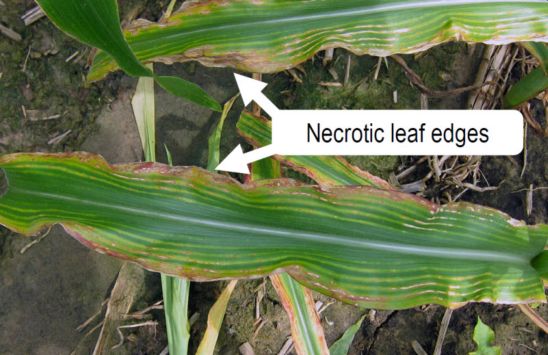Magnesium, an Essential Plant Nutrient
- Mobile within the plant
- Critical for several functions:
- Central element in the chlorophyll molecule
- Transport of phosphorus
- Enzyme activation
- Nutrient uptake functions
- Oil and fat production
- Translocation of starch
Magnesium Deficiency Symptoms
- Often confused with other nutrient inadequacies
- May be positively identified by:
- Visual and physiological symptoms
- Soil chemical analysis
- Plant mineral (tissue) analysis
Visual and Physiological Symptoms
- Interveinal chlorosis (yellow to white)
- Necrotic edges
- Purpling of the lower (older) leaves
- Interveinal beading
- Shorting of the internodes (in severe cases)



Favorable Conditions
Soil Physical and Chemical Properties That May Favor Magnesium Deficiencies:
- Low cation exchange capacity (CEC) (sandy/silty soils)
- Low to moderate pH (< 6.5)
- High cation levels K+, NH4+, Na+, Ca2+, Al3+, Fe2+
- Low soil temperatures
- Highly permeable soils with excessive soil moisture
Notes on Soil Complexity
- It may take more than one of the specific situations above to induce magnesium deficiency
- Soil is a dynamic system and can change rapidly – spatially and temporally
- Magnesium deficiencies can be dependent on year-to-year or month-to-month changes in growing conditions or fertilizer additions (K+, NH4+)
Plant Mineral (Tissue) Analysis
- Can be a critical tool in identifying magnesium deficiency
- Take 16+ random samples throughout the deficient area
- Sample the youngest fully collared leaf until ear leaf formation
- After ear leaf formation, indicate to your lab at which reproductive stage samples were taken
- Most importantly, follow your laboratory's specific sampling procedures
Table 1. Critical magnesium (Mg) ranges for several physiological growth stages in corn
(Lockman,1969)

a Whole plant sample taken 24 to 45 days after emergence
b 3rd youngest fully collared leaf taken 45 to 80 days after emergence
c Plant tissue sample taken from ear leaf (green silk to dent)
Table 2. Some critical nutrient values for corn ear leaves silking / tasseling
(Jones and Eck, 1973)

Treatments for Magnesium Deficiency
When a magnesium deficiency is conclusively identified remedial and preventive treatments may be needed.
- Foliar applications
- Commercial magnesium products
- Epsom salt solution
- Soil applied magnesium fertilizer applications
- Dolomitic lime applications
- Dolomitic lime is the best long term solution in acidic soils
- Provides a magnesium mineral (fertilizer) source
- Raising soil pH makes soil magnesium more available
Figure 1. Relative availability of magnesium, calcium, and iron in low CEC soils. Even at close to optimum pH levels, magnesium can still be unavailable in some situations

Table 3. Recommended magnesium application rates and methods (Spectrum Analytic, 2010)

Table 4. Fertilizer sources and magnesium (Mg) percentage by weight (Spectrum Analytic, 2010)
